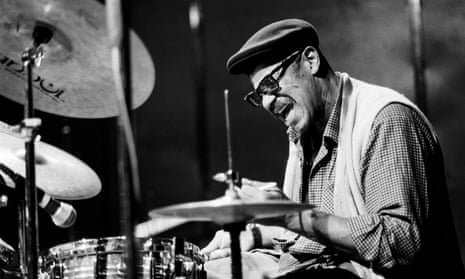Steering a number of people towards doing the same things at the same time – marching in step, singing a tune, fighting in formation – has frequently been a job for drummers, all the way back to when tabor players guided courtly dancers and the manoeuvres of battlefield pikemen in the Middle Ages. But the craft has often had a different character outside Europe – notably in African cultures, where looser and more intuitive percussion traditions evolved alongside ceremonies, celebrations, rituals and the expression of emotion.
The jazz drummer Sunny Murray, who has died 81, was a particularly free-thinking descendant from those African origins. The American writer Amiri Baraka called him “a conductor of energies”, and Murray’s playing did indeed evoke for many the impressions of restless seas, buffeting winds or the ebbs and flows of feelings, rather than the snap and patter of drummers organising action by playing rudiments. Moreover, Murray did not seek to “accompany” partners in a co-operative way, but instead inhabited a parallel world which other improvisers could enter, wrestle with, find solace in or leave at will.
The rise of more loosely structured, freely improvised jazz in America in the 1960s made Murray’s emergence and eventual acceptance possible. In combination with two of free-jazz’s most radical innovators – the pianist Cecil Taylor and the saxophonist Albert Ayler – he became a significant influence on both ensemble improvisation and the rhythmic evolution of solo-jazz phrasing.
Murray was born in Idabel, Oklahoma. His father, James, was a preacher and labourer, and his mother, Myrtle (nee Rice), a music-loving domestic worker. Growing up in Philadelphia, Sunny took up the drums at the age of nine. He had a stormy, gang-blighted adolescence in one of the city’s toughest districts, served a two-year sentence at a reformatory, experimented with the trumpet and trombone, and moved to New York in 1956.
He found a drumkit abandoned in a club after a police raid, began studying percussion techniques more seriously, supporting himself by working in car-washes and a steel factory (losing part of two fingers in the latter) and by the end of the 1950s was performing with the swing trumpeter Henry “Red” Allen and the saxophonists Rocky Boyd and Jackie McLean. But when he met Taylor, who wanted a less explicitly rhythmic and pulse-rooted approach than was common among drummers at the time, Murray’s creative life was transformed.
Inspired by Taylor’s fusion of blistering classical-keyboard virtuosity and wilful experimentation with harmony and improv-narrative shape, and by the drummer Elvin Jones’s tonal range and melting of rudiment-patterns into a lava-like flow, Murray left orthodox jazz behind – and most of his former employers along with it.
After their first chance meeting, Murray had to hunt for the reclusive Taylor’s whereabouts in New York. He eventually occupied a loft in the same building – and would play for the pianist while he lay in bed. One day Taylor got up to join him at the piano, and, as Murray related to the writer Val Wilmer, simply said, “I want you to play something like you never played before.” Wilmer reported in her book As Serious As Your Life (1977) that Murray then took three years to fully appreciate that Taylor was drawing him away from time-keeping towards a completely different conception of drumming.
He performed with Taylor on the composer Gil Evans’s album Into the Hot (1961), and joined the pianist and his saxophonist Jimmy Lyons on a Scandinavian tour marked by a sensational Taylor-led recording (Nefertiti, the Beautiful One Has Come) at Cafe Montmartre, Copenhagen, in which the sense of a new musical era being born transcended the shortcomings of sound quality. Ayler joined the trip, and Murray worked regularly with him from December 1963. Murray contributed to the volatile Ayler’s most enduring legacy, by playing at his majestically unfettered best in 1964 and 65 on the albums Witches and Devils, Spirits Rejoice, Bells, and Spiritual Unity.
Murray began working and recording as a band leader with American free-jazz luminaries including Archie Shepp, Lester Bowie, Roscoe Mitchell and Malachi Favors. DownBeat magazine gave him a New Star award in 1966, but Murray marched to the publication’s offices to burn it because there was no cash attached – a protest at the Cinderella status of adventurous jazz-making that many practitioners readily identified with.
Murray worked with a creative mix of European and US musicians after his relocation to Paris in 1968, and in the 1990s he made powerful original music with the free-jazz saxophone improviser Charles Gayle. Murray also struck up a productive relationship with the British saxophonist Tony Bevan and the double bassist John Edwards, documented on the unexpectedly intimate and delicate album The Gearbox Explodes (2006) and the studio session I Stepped Onto a Bee (2010).
Strength and intensity at the drumkit were the variables that mattered most to Murray – and he felt convinced in the late 1960s that he was the one drummer capable of conveying the new levels they had then reached in jazz. He was also uncompromising about the pressures he would apply, both to himself and to collaborators. “When this is over,” he said to Wilmer, describing a playing situation with an aspiring young drummer, “he realises that he is in a completely different state of being, confronted with not just the sound of drums but the sound of the crashing of cars and the upheaval of a volcano and the thunder of the skies. He never imagined himself being locked in a room with these kinds of sounds.”
Murray is survived by his partner, Isabelle Soumilliard, three sons, James, Haniff and Oforie, and a daughter, Pia, two grandchildren and his half-brother, Conny.
Sunny Murray (James Marcellus Arthur Murray Jr), drummer, born 21 September 1936; died 7 December 2017

Comments (…)
Sign in or create your Guardian account to join the discussion